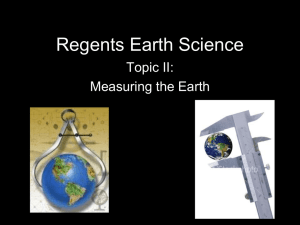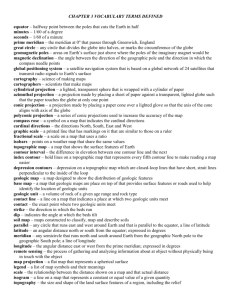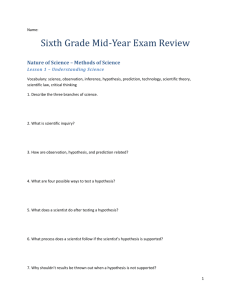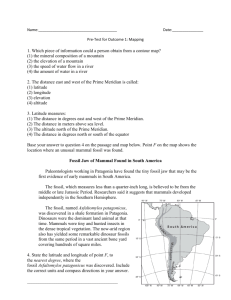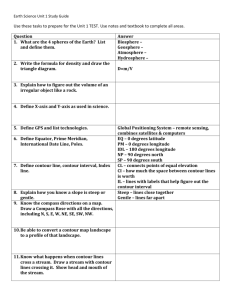Chapter 3 Combined Notes
advertisement
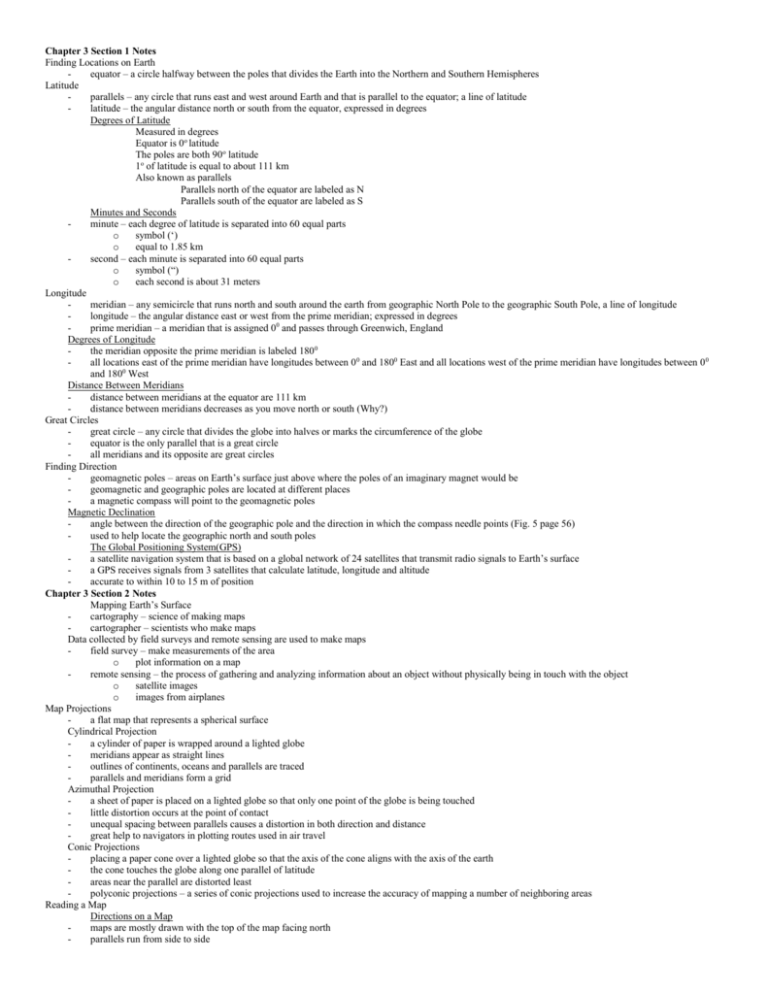
Chapter 3 Section 1 Notes Finding Locations on Earth equator – a circle halfway between the poles that divides the Earth into the Northern and Southern Hemispheres Latitude parallels – any circle that runs east and west around Earth and that is parallel to the equator; a line of latitude latitude – the angular distance north or south from the equator, expressed in degrees Degrees of Latitude Measured in degrees Equator is 0o latitude The poles are both 90o latitude 1o of latitude is equal to about 111 km Also known as parallels Parallels north of the equator are labeled as N Parallels south of the equator are labeled as S Minutes and Seconds minute – each degree of latitude is separated into 60 equal parts o symbol (‘) o equal to 1.85 km second – each minute is separated into 60 equal parts o symbol (“) o each second is about 31 meters Longitude meridian – any semicircle that runs north and south around the earth from geographic North Pole to the geographic South Pole, a line of longitude longitude – the angular distance east or west from the prime meridian; expressed in degrees prime meridian – a meridian that is assigned 00 and passes through Greenwich, England Degrees of Longitude the meridian opposite the prime meridian is labeled 180 0 all locations east of the prime meridian have longitudes between 0 0 and 1800 East and all locations west of the prime meridian have longitudes between 0 0 and 1800 West Distance Between Meridians distance between meridians at the equator are 111 km distance between meridians decreases as you move north or south (Why?) Great Circles great circle – any circle that divides the globe into halves or marks the circumference of the globe equator is the only parallel that is a great circle all meridians and its opposite are great circles Finding Direction geomagnetic poles – areas on Earth’s surface just above where the poles of an imaginary magnet would be geomagnetic and geographic poles are located at different places a magnetic compass will point to the geomagnetic poles Magnetic Declination angle between the direction of the geographic pole and the direction in which the compass needle points (Fig. 5 page 56) used to help locate the geographic north and south poles The Global Positioning System(GPS) a satellite navigation system that is based on a global network of 24 satellites that transmit radio signals to Earth’s surface a GPS receives signals from 3 satellites that calculate latitude, longitude and altitude accurate to within 10 to 15 m of position Chapter 3 Section 2 Notes Mapping Earth’s Surface cartography – science of making maps cartographer – scientists who make maps Data collected by field surveys and remote sensing are used to make maps field survey – make measurements of the area o plot information on a map remote sensing – the process of gathering and analyzing information about an object without physically being in touch with the object o satellite images o images from airplanes Map Projections a flat map that represents a spherical surface Cylindrical Projection a cylinder of paper is wrapped around a lighted globe meridians appear as straight lines outlines of continents, oceans and parallels are traced parallels and meridians form a grid Azimuthal Projection a sheet of paper is placed on a lighted globe so that only one point of the globe is being touched little distortion occurs at the point of contact unequal spacing between parallels causes a distortion in both direction and distance great help to navigators in plotting routes used in air travel Conic Projections placing a paper cone over a lighted globe so that the axis of the cone aligns with the axis of the earth the cone touches the globe along one parallel of latitude areas near the parallel are distorted least polyconic projections – a series of conic projections used to increase the accuracy of mapping a number of neighboring areas Reading a Map Directions on a Map maps are mostly drawn with the top of the map facing north parallels run from side to side - meridians run from top to bottom compass rose – a symbol that indicates the cardinal directions(north, south, east, west) Symbols symbols are used for features on a map such as cities, roads and rivers legend – a list of map symbols and their meanings Map Scales a map must be drawn to scale to be accurate scale – the relationship between the distance shown on a map and the actual distance graphic scale – printed line that has markings on it that are similar to those on a ruler fractional scale – a scale that uses a ratio Isograms a line on a map that represents a constant or equal value of a given quantity used to plot many types of data (i.e., atmospheric pressure on a map) commonly used to show areas that similar measurements of precipitation, temperature, gravity, magnetism, density, elevation or chemical composition Chapter 3 Section 3 Notes Types of Maps Topographic Maps one of the most widely used topographic map – shows the surface features of earth topography – the size and shape of the land surface features of a region including its relief shows both natural features and constructed features shows elevation – the height of an object at sea level Advantages of Topographic Maps more detailed information about the surface shows the size, shape and elevation Elevation of Topographic Maps contour lines – a line that connects point of equal elevation on a map contour lines are isograms that connect points contour interval – difference in elevation between two contour lines contour interval is determined by the relief of the land relief – the difference between the highest and lowest elevations in a given area index contours – every fifth contour line bolder than the other contour lines o makes reading the map easier Landforms on Topographic Maps spacing and direction of contour lines indicate the shapes of the landforms represented widely spaced contour lines indicate change in elevation is gradual closely spaced contour lines indicates change in elevation is rapid a “V” shape indicates a valley o the bend in the “V” points toward the higher end o a “V” indicating a stream or river always points upstream o width of the “V” shows the width of the valley depression is indicated by depression contours – closed-loop lines that have short, straight lines perpendicular to the inside of the loop Topographic Map Symbols black – buildings, boundaries, roads and railroads red – major highways green – forested areas purple – information updated by aerial photography but not verified by field exploration Geologic Maps designed to show the distribution of geologic forms geologic maps are created on top of another map called a base map base map – provides surface features, such as topography or roads usually printed in light colors or as grey lines Rock Units on Geologic Maps geologic unit – a volume of rock of a given age range and rock type geologic units are distinguished by color assign a set of letters to each rock unit o capital letter symbolizes the age of the rock o lowercase letters represent the name or the unit or rock type Other Structures on Geologic Maps contact lines – indicates places at which two geologic units meet contact – the actual place where two geologic units meet o faults o depositional contacts o strike – direction in which beds run o dip – the angle at which beds tilt Soil Map constructed to classify, map and describe soils based on soil surveys Soil Surveys text o geology o topography o climate of the area tables o types of soil o volumes of soil maps o approximate location of different types of soil o detailed information about the soils in the area Use of Soil Maps valuable tools for agriculture and land management helps identify ways to conserve and use soil and plan sites for future development Other Types of Maps location and flow of both water and air record and predict weather amount of precipitation location and direction of the flow of groundwater changes in Earth’s surface over time
